Data & Analytics
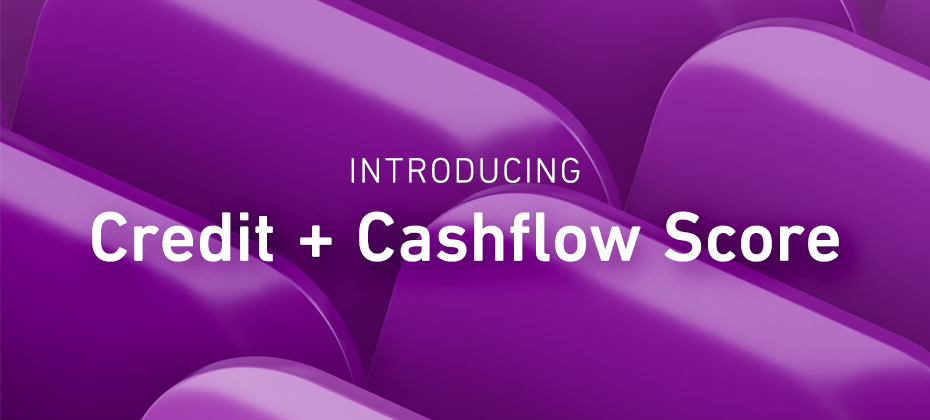
Every credit decision relies on data, but traditional credit information may capture only part of a consumer’s financial story. Some of that story is reflected in credit reports, the loans repaid, the cards managed, and the steady progress toward financial goals. Others live quietly in bank statements and transaction histories, like the rent paid on time, the savings set aside, and the bills managed responsibly. Yet for millions of consumers, that second story has rarely been part of the credit conversation. Expanding the credit conversation can give lenders and financial institutions an edge, helping them separate genuine risk from missed opportunity. In a lending environment defined by volatility and evolving consumer habits, having a more complete picture of each applicant can help make the difference between sustainable growth and risk management. At the same time, open-banking frameworks and consumer-permissioned data have made it possible to understand financial health more clearly than traditional models. That’s where Experian’s Credit + Cashflow Score comes in. A unified view of credit and cash flow The Credit + Cashflow Score is the first-of-its-kind model combining multiple data sources into a single score. Based on our pre-production analytics, early results demonstrate a 40% improvement in predictive accuracy compared with conventional credit models. It unites our proprietary and industry-leading credit data, alternative credit insights, 24 months of trended behavior, and consumer-permissioned cashflow information into a single score ranging from 300 to 850.* This goes beyond cashflow-augmented models that rely primarily on transaction data layered over credit files. The result is a data-rich assessment of creditworthiness that allows lenders to strengthen portfolio performance, maintain disciplined risk management, and help identify qualified borrowers that traditional credit models might overlook. Better risk control and stronger growth Today’s lending landscape is being reshaped by rising interest rates, increased capital costs, and heightened regulatory oversight. These pressures are prompting institutions to tighten underwriting standards and reassess risk strategies as they navigate an uncertain economy. At the same time, competition for qualified borrowers continues to intensify, creating pressure to drive sustainable growth without compromising credit quality. Meanwhile, on the consumer side, people are earning income through gig work or multiple income streams and using alternative financial products. According to our recent market estimates, 62 million U.S. consumers are thin-file or credit-invisible1. This is making it harder for lenders to assess true financial capacity using credit data alone. Traditional credit scores continue to remain important, but they can potentially miss key indicators of stability and affordability that appear only in transactional data. The Credit + Cashflow Score bridges that gap, helping enable lenders to expand approvals responsibly while maintaining disciplined risk management. See what's next As credit markets continue to evolve, lenders are looking for new ways to balance growth with risk. Having the whole financial picture may allow organizations to grow stronger portfolios, reach more qualified borrowers, and bring financial opportunity to more people. Partner with Experian to leverage decades of credit expertise, the nation’s largest alternative credit bureau, and industry-leading open-banking solutions to help lenders innovate responsibly. The Credit + Cashflow Score is built to deliver measurable performance lift, model transparency, and ease of integration through the Experian Ascend Platform. Learn more about the Experian Credit + Cashflow Score * New score available in pre-production for analytics 1https://www.experian.com/thought-leadership/business/the-roi-of-alternative-data

Why data analytics matters more to fintech lenders Unlike traditional financial institutions, fintechs grow through rapid experimentation. They build, iterate and deploy at a pace that rewards agility but often exposes gaps in visibility. That’s why unified, trusted data has become essential infrastructure. Many fintech leaders note that building technology is rarely the barrier; the real challenge is ensuring their data can move as quickly as their decisions. Analytics plays a central role in closing that gap by providing real-time insight that supports speed, accuracy and confidence. Fintech analytics goes far beyond reporting. It’s about connecting credit, cash flow and behavioral data to reveal intent, detect risk early and personalize offers. The leaders in this space aren’t those with the most data, but those who can turn it into confident, compliant action. How fintechs are using analytics to stay ahead 1. Managing risk in real timeFintech lenders are increasingly recognizing that the boundary between fraud and credit risk is disappearing. Rather than treating them as separate disciplines, leading firms are developing unified approaches that detect early behavioral signals that indicate financial stress or potential fraud well before losses occur. By fusing transactional and credit data, they are creating adaptive risk models that evolve in real time and deliver faster, more confident decisions. 2. Unlocking value from cash flow and alternative dataFintechs are finding that cash flow tells a richer story than credit alone. By layering bank transaction data on top of bureau insights, many have improved model accuracy and expanded their reach to consumers who might otherwise be overlooked. Analysis of BNPL activity, primary account behavior and income patterns is also helping lenders tailor offers with greater precision and fairness. 3. Accelerating innovation with governed AIAI is driving model development and decisioning speed, but governance remains a universal concern. Fintech leaders acknowledge the challenge of balancing innovation with regulatory transparency, emphasizing the need for faster validation, clearer audit trails and explainable outputs. The next frontier isn’t just building smarter models but ensuring those models are trusted by compliance teams, investors and consumers alike. Persistent pain points in fintech data integration For many fintechs, they are challenged by knowing, that the data exists, but the stitching between sources slows everything down. Even the most advanced fintechs face familiar challenges: Fragmented data ecosystems: Transactional, credit, and behavioral data often live across disconnected systems, creating blind spots and latency. Data quality and recency: Incomplete or outdated information weakens the accuracy of AI models. Scalability and governance: Rapid growth amplifies infrastructure strain and regulatory complexity. Where Experian gives fintechs an edge Fintechs have a need for control, speed and trust — a balance that’s difficult to achieve with point solutions or legacy integrations. That’s where Experian differentiates. The Experian Ascend Platform™ brings data, analytics and decisioning together in a single, secure environment so fintechs can: Access unified, model-ready data that combines credit, cash flow and alternative sources. Build, test, and deploy predictive models through sandbox capabilities that mirror real-world conditions. Enhance transparency and compliance with built-in AI governance and audit tools. Integrate seamlessly through flexible APIs designed for engineering-led teams. Several fintech leaders have stated that Experian’s Ascend platform’s performance and transparency help them move faster without compromising oversight, giving them the speed of an in-house build with the reliability of a proven data partner. The takeaway: from data collection to confident decisioning For fintech lenders, analytics is no longer a back-end function. It is a strategic capability that drives every decision. Those who unify their data, operationalize insights responsibly and automate decisions with transparency will set the pace for the next wave of credit innovation. Experian continues to partner with leading fintechs to transform fragmented data into real-time intelligence, powering smarter lending, sharper risk controls and stronger customer experiences built on trusted data. Discover how Experian’s fintech solutions are helping fintechs harness analytics to accelerate growth and innovation. Learn more

In today’s fast-moving financial services landscape, fintechs face a dual challenge: scaling profitably while managing increasingly complex risk. From credit underwriting to fraud prevention, every decision carries both opportunity and exposure. That’s why forward-looking fintech leaders are turning to data-driven credit risk management strategies to sharpen decision-making, enhance compliance and unlock growth. Why data-driven risk management matters in fintech Fintechs are navigating an environment shaped by rapid innovation, shifting regulations and evolving consumer expectations. Within this landscape, three challenges come to the forefront: Evolving fraud threats: Fraudsters are advancing quickly, exploiting digital onboarding and consumer data. Siloed functions: Traditionally, credit, fraud and compliance were separate, but as fraud detection becomes a higher priority, forward-looking companies are now integrating these functions, with84% planning to share more data across the industry to help prevent fraud.1 Operational complexity: Fintechs must balance growth with compliance, often with lean teams, tech-debt that demands a strong return on investment (ROI)and aggressive timelines. These challenges make it clear that static, one-dimensional risk measures are no longer sufficient. By leveraging a unified decisioning platform that incorporates behavioral data and advanced analytics, fintechs can gain a more holistic view of consumer financial behavior. This broader perspective not only improves the accuracy of credit assessments but also strengthens defenses against sophisticated fraud threats. Driving efficiency through automation A data-driven risk management strategy is only as effective as its ability to be executed at scale. This is why automation is no longer a nice-to-have, but a competitive necessity in an industry defined by speed, complexity and rising consumer expectations. By embedding automation into credit and fraud risk management processes, fintechs can create systems that are more efficient, resilient and compliant. Key advantages include: Increased underwriting efficiency: Combined with data-driven insights, automated decisioning platforms allow fintechs to evaluate applications quickly and more accurately, resulting in faster and fairer credit decisions. Portfolio growth: Leveraging expanded data and automation allow enables smarter customer segmentation and more precise risk-based pricing, driving broader market reach and greater profitability. Fraud mitigation: Automated identity verification helps fintechs quickly validate customers, reduce friction in the onboarding process and block fraudulent activity before it impacts portfolios. Regulatory readiness: Unified, automated risk processes enable fintechs to adapt quickly to regulatory shifts, fraud trends and market disruptions, building long-term sustainability. Comparing legacy and modern credit risk approaches in fintech Data and automation have become essential for executing risk strategies at scale, highlighting just how far credit risk management has evolved. Below are key differences between traditional and modern approaches to credit risk. FeatureLegacy approachData-driven approachRisk detectionPoint-in-time scoresTrajectory-based modelingFraud preventionManual reviewAutomated, behavioral analyticsComplianceSiloed functionsUnified decisioning platformCustomer experienceSlow, manualFast, fair, automated Why fintechs choose Experian® As fintechs navigate an environment of increasing regulation, fraud sophistication and consumer expectations, the winners will be those who embrace a data-driven, automated and converged approach to credit and fraud risk management. Experian offers fintechs a partner with unmatched data accuracy, robust alternative data capabilities and end-to-end decisioning solutions designed for today’s converged risk landscape, including: Trended 3DTMattributes capture 24 months of key consumer credit activity, enabling fintechs to better manage portfolio risk and determine next best actions. Cashflow Score leverages consumer-permissioned banking transaction data to predict the likelihood of a borrower going 60+ days past due in the next 12 months, providing deeper visibility into financial health and repayment capacity. PowerCurve® is a unified, automated decision engine that incorporates data, strategy design, decision automation and detailed monitoring and reporting to help fintechs streamline credit decisions with speed and consistency. Our behavioral analytics capabilities, powered by NeuroID, provide a seamless, invisible gauge of user risk, allowing fintechs to proactively mitigate fraud while creating a secure, low-friction customer experience. Frequently asked questions What is data-driven risk management in fintech? It’s the application of advanced analytics, behavioral data and automation to help fintechs improve credit risk assessment, fraud prevention and compliance in digital-first environments. How does automation help fintechs manage credit risk? Automation enables fintechs to scale efficiently by streamlining underwriting, minimizing manual errors and ensuring consistent decision-making. What are the benefits of unified decisioning platforms? Unified platforms integrate credit, fraud and compliance decisions into a single workflow, helping fintechs onboard customers faster, respond quickly to fraud threats and maintain compliance without slowing down innovation. Discover how our fintech solutions can help your fintech strengthen credit risk management, reduce fraud and accelerate growth. Learn more 1Experian Vision

As fraud continues to rise in the rental housing market, tenant screening practices are evolving. In an earlier blog, I explored how Experian Observed DataTM can provide early indicators of income and employment consistency, offering screening companies a way to reduce reliance on costly or time-intensive verification methods. In this follow-up, I explore two additional tools that strengthen the tenant screening process: Experian VerifyTM for Research Verifications and Experian Verify for Permissioned Verification's AI-powered Document Review. Used together, these solutions enable a layered approach that boosts both efficiency and prevention of fraud. Modernized Research Verifications Manual employment and income and employment checks—once the standard for tenant screening—are time-consuming and often inconsistent. Traditionally, screening companies had to reach out directly to employers and request proof of employment. While still useful, this method puts pressure on internal resources and is not always scalable. To streamline manual verification, many organizations are partnering with third-party providers, especially those that take a digital-first approach. Outsourcing allows screening companies to delegate outreach, follow-ups, and fraud detection to specialized teams trained in document validation and employer communication. These services deliver the same insights internal teams would gather, while freeing up in-house resources for more strategic initiatives. By leveraging digital tools such as conversational AI, online forms, and automated workflows—combined with human oversight—digital-first vendors offer a more scalable and cost-effective alternative to fully manual processes. This approach not only reduces operational costs but also shortens turnaround times, helping screening companies respond faster without compromising accuracy or fraud resistance. Key advantages:[MJ1] Reduces the burden on internal staff Ensures consistency and fraud awareness in document review Provides a reliable fallback when other verification tools return limited data This approach is especially valuable when initial data sources yield incomplete results and further confirmation is required. AI-Enhanced Document Upload and Review Another common scenario in tenant screening is the submission of income documents by the applicant, often in the form of paystubs or bank statements. Manual review of these documents is prone to error and increasingly vulnerable to sophisticated forgeries, including those generated by artificial intelligence. AI-powered document analysis tools are now helping screening companies process uploaded documents more securely and efficiently. These platforms typically work by: Allowing applicants to upload documents through a secure portal Using AI to scan for signs of tampering, fabrication, or inconsistency Returning standardized results that are easier to evaluate and compare By automating the detection of anomalies and potential fraud indicators, these tools reduce the workload for staff while improving the reliability of the review process. Benefits include: Faster review and turnaround times Improved fraud detection capabilities Greater consistency across applicants This method is especially useful when traditional employer APIs are unavailable or when screening companies need additional confirmation beyond initial data sources. A Layered Approach to Verification By combining different verification methods, screening companies can design workflows that adapt to a wide range of applicant profiles and risk scenarios. A layered strategy might include: Starting with an inexpensive source of income or employment data to identify likely matches Using AI-based document review when additional validation is needed Turning to manual research verifications only when necessary This cascading process allows screening companies to control costs while maintaining a strong defense against fraud. It also ensures that higher-cost methods are used only when the earlier steps do not provide enough confidence to proceed. Modern Challenges Require Modern Solutions Fraud in tenant screening is increasing rapidly. According to industry surveys, over 93 percent of screening companies have encountered fraud in the past year, and the majority have dealt with falsified income documentation. Traditional approaches, especially manual review, are no longer sufficient on their own. By rethinking verification strategies and incorporating modern tools like outsourced research verification and AI-enhanced document review, screening companies can reduce risk, improve efficiency, and better prioritize their resources. Learn More For organizations interested in implementing these types of verification tools, several providers—including Experian—offer services designed to support this layered approach. These solutions can help screening companies strike the right balance between cost, compliance, and fraud resistance. To learn more, visit experian.com/verify.

Mid-sized banks are large enough to pursue ambitious growth strategies, like expanding loan portfolios or entering new markets, but not so large that they can withstand major credit losses without consequence. So how do lending organizations manage their credit risk strategies to grow without taking on more risk than they can handle?

Credit decisioning has traditionally relied on static data like credit bureau scores, income statements, and past repayment history. As financial behavior becomes more dynamic and consumer expectations shift toward instant decisions, real-time data is emerging as a powerful tool in reshaping how lenders assess risk.
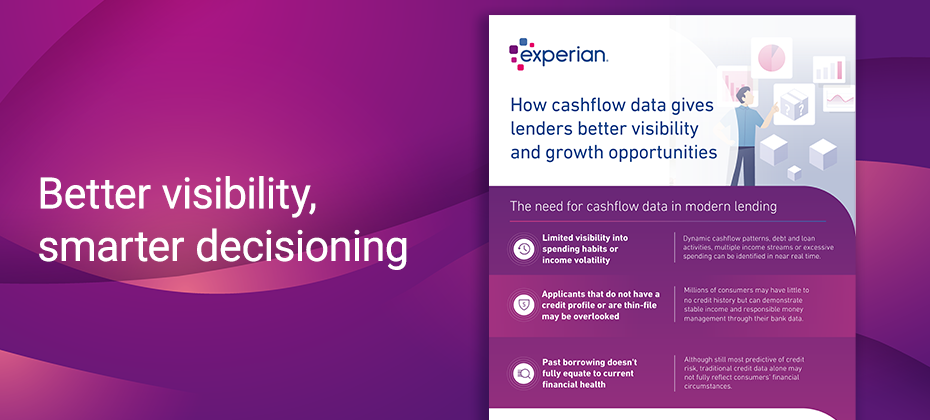
In today’s evolving economic climate, lenders face a growing challenge: how to accurately assess creditworthiness — especially for consumers with limited credit histories. That’s where cash flow insights come into play. Our latest infographic illustrates how cashflow data helps lenders achieve a more comprehensive understanding of borrowers' financial health. What you'll learn: Why cashflow data is essential for modern, inclusive lending The key financial behaviors that cash flow insights can uncover How these insights help lenders expand market reach and make more precise decisions Read the infographic to learn more. View infographic

Financial institutions are sitting on a goldmine of data: customer transactions, credit histories, digital interactions, and more. But the real value is found when that data is transformed into insights that drive smarter decisions, faster responses, and better outcomes for both the business and consumers.

Risk management specialists, marketing departments, and customer success teams often work from different data sets, leading to inconsistent insights and missed opportunities. A unified data strategy can help break down these silos and unlock the full potential of an organization’s ability to turn raw data into actionable insights.
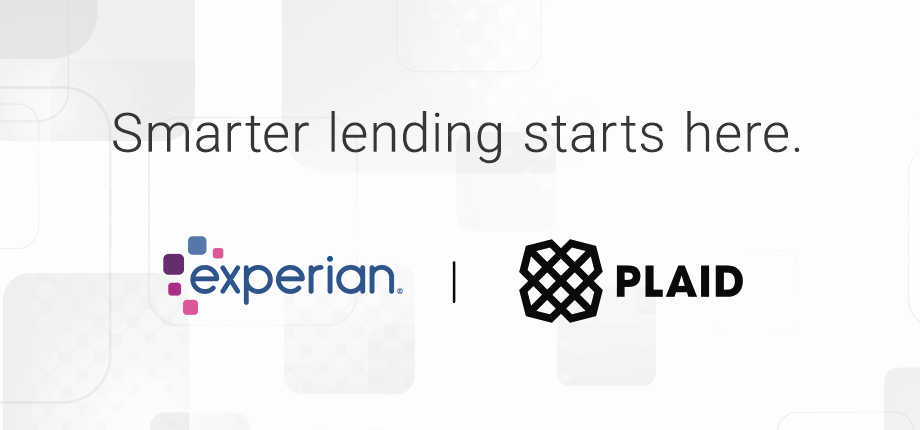
Experian and Plaid are teaming up to power smarter, faster, and more inclusive lending — fueled by real-time cash flow insights. The financial landscape is becoming more dynamic and digitally connected. Consumers are increasingly turning to digital platforms not only to pay bills and track spending, but to better understand their financial health, monitor their credit standing, and plan confidently for the future. This evolution presents a timely opportunity for innovation in underwriting — one that empowers consumers to take control of their financial futures and enables lenders to make faster, smarter, and more inclusive decisions. What happens when the leading global data and technology company joins forces with the largest open banking network in the world? Experian and Plaid are coming together to solve some of the most pressing challenges lenders face, bringing cash flow insights into credit decisions, seamlessly. Smarter lending: Elevating the credit decision process For lenders seeking a holistic view of borrowers to make faster, more informed decisions, this new collaboration is a game-changer. Experian and Plaid are combining real-time, unmatched cash flow data and analytics to help lenders improve decisioning, pinpoint risk precisely, and drive financial inclusion. This marks a pivotal shift in how credit is assessed, moving us toward faster, and fundamentally smarter lending decisions. This strategic collaboration delivers real-time cash flow insights in a comprehensive solution, built on core principles designed to directly enhance your lending capabilities: Speed and simplicity: Driving efficiency with seamless integration In today’s fast-paced financial landscape, efficiency in underwriting isn’t just an advantage; it’s a necessity. Our combined solution prioritizes speed and simplicity by offering easy integration through APIs. This ensures fast access to meaningful risk insights, streamlining your workflows. Imagine easily leveraging real-time cashflow risk insights directly into your existing processes for faster and smarter lending decisions. This is about delivering modern infrastructure that allows you to move at the speed of today's market, empowering your business to expand with confidence. Broader visibility: Unveiling a holistic consumer view Traditional credit scores are a reliable, crucial tool for measuring a borrower’s creditworthiness. When coupled with real-time cashflow data and risk insights, lenders are empowered with broader visibility, bringing to light a more holistic view of a borrower’s current financial reality and opportunities that may have been missed. You gain a comprehensive consumer financial picture, allowing for more precise identification of both strong financial capacity and potential risks, ultimately helping you target and acquire customers who align with your growth objectives. Smarter decisions: Enhancing models with combined intelligence The power to make truly informed decisions hinges on the quality and depth of your data. Without robust insights, risk models can be limited, impacting precision and speed. With Experian's advanced cash flow analytic capabilities and Plaid's streamlined access to real-time cash flow data via Consumer Report, you can enhance your risk assessment for smarter decisions. This synergy empowers financial institutions to expand credit access and uncover hidden risks, leading to more precise underwriting. It’s about leveraging advanced analytics in real-time to drive improved decision-making and build stronger portfolios. More inclusive lending: Expanding access, responsibly A significant challenge in lending is ensuring access for all creditworthy individuals, including those with limited traditional credit histories who may be overlooked. This represents an untapped market and a vital opportunity for responsible growth. Our solution champions more inclusive lending, enabling you to reach underserved communities and empower consumers who demonstrate strong financial capacity. This not only fosters stronger portfolios but critically helps your business grow by efficiently acquiring customers across a broader spectrum. Proven trust: Lending with confidence In the financial industry, the bedrock of any solution is trust – in the data, security, and partners. Lenders require unwavering confidence in the tools they adopt. This collaboration is built on proven trust, leveraging the reach, reliability, and security of two of the most trusted names in financial services. Experian’s expertise in credit data and consumer protection, combined with Plaid’s modern infrastructure and trusted open banking network, offers unparalleled assurance. You can securely integrate these powerful insights, knowing you are backed by industry leaders committed to best-in-class security and compliance, enabling your business to grow with confidence without compromise. Smarter lending starts now The evolution of underwriting demands a more dynamic, inclusive, and precise approach. With Experian and Plaid, you're not just adapting to change; you're leading it. Empower your organization to approve more borrowers, reduce risk more effectively, and make smarter, faster decisions for sustainable success. Ready to transform your lending strategy? Learn more about how to bring cash flow insights into your credit decisions seamlessly. Learn more
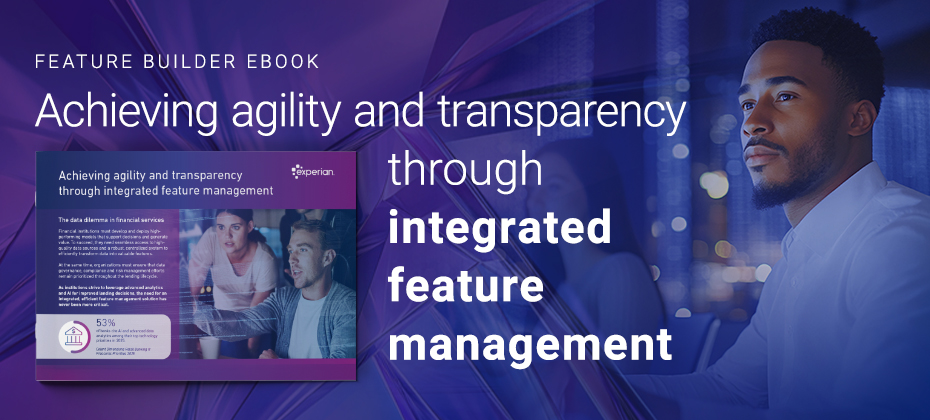
For financial institutions to achieve success, they need to develop high-performing models with easy access to top-tier data sources. It’s also important to focus on data governance, compliance, and risk management throughout the lending lifecycle. Industry leaders implement advanced analytics and AI solutions to improve their lending decisions, and they also incorporate integrated, efficient feature engineering into their business operations. What’s feature engineering? Feature engineering helps organizations turn raw data into comprehensive model development, following this process: Data collection Data cleaning and transformation Feature engineering Model training and evaluation Decision-making Effectively transforming data into valuable insights depends heavily on creating new custom features to enhance model performance, as well as the quality of the data being used. When data is fragmented or managed poorly, it can lead to increased operational costs, missed revenue opportunities, and compliance risks. Our feature engineering solution: Experian Feature Builder Financial institutions require optimized workflows that can accelerate development while supporting governance and ensuring transparency. Experian’s feature engineering tool, Experian Feature Builder, streamlines custom feature development and deployment across the modeling lifecycle. Providing access to 20+ years of proprietary data, Experian Feature Builder enables organizations to: Break data silos by creating unified access across multiple data types Ensure trust and compliance by embedding audit and lineage tracking at each stage Enable strategic agility with faster and more consistent feature experimentation, testing, and deployment Download our latest e-book to find out more about how Experian’s Feature Builder provides centralized feature development to accelerate time-to-market, enhance compliance, and minimize risk. Download the e-book

Generative AI (GenAI) is transforming the financial services industry by boosting operational efficiency, cutting costs, and enhancing customer experience. Today, industry leaders are leveraging GenAI technology to accelerate the modeling lifecycle, streamline workflows, and ensure regulatory compliance. However, financial institutions face several headwinds in their efforts to achieve strong business results. What industry challenges do financial institutions face? To drive profitability while fueling growth, organizations need to reduce costs, manage risks, and identify new revenue streams while complying with regulatory requirements. Growing customer bases are also a top priority for banking leaders in 2025, requiring personalized services and improved customer experiences to attract and retain customers.1 Staying one step ahead of the competition is another hurdle that many organizations need to overcome. A recent study states that 23% of U.S. consumers surveyed have opened a new bank account, and 28% have considered switching to a new bank in the past six months.2 Traditional financial institutions must continuously innovate to stay on pace with smaller, more agile fintech companies. Adopting technologies like GenAI is an effective way to stay relevant and top-of-mind with consumers. Why use GenAI technology in financial services? Financial organizations that use GenAI are achieving success by: Increasing productivity and efficiency Minimizing costs Strengthening customer relationships GenAI has revolutionized productivity, customer service, risk management, and financial data analysis within the financial services industry. Of all the various measurements of AI use, improved productivity was reported to be the leading indicator of successful implementation.3 Online tools like virtual assistants and chatbots provide personalized experiences to consumers and resolve issues in real time, leading to enhanced customer satisfaction. This AI technology reduces the workload on human agents and enables organizations to deliver value more quickly and with less friction. GenAI adoption at Experian Experian® is a leader in GenAI solutions, using advanced technology to manage and improve data. We champion responsible AI use, ensuring proper consumer data privacy, compliance, fraud prevention, and greater financial access and inclusion. Experian Assistant is our latest innovation in GenAI helping financial institutions to accelerate the modeling lifecycle, which enhances efficiency, reduces expenses, and promotes customer growth. Experian Assistant allows businesses to build and deploy models, monitor performance, and go to market more quickly and with less friction, which can translate to more business success. The tool provides instant expert recommendations and insights with comprehensive support, enabling users to make smarter and faster data-driven decisions. This technology offers multiple functions that are crucial for optimizing business efficiency: Natural language interface Deep insights into underlining data tables and metrics Reduced operational and cloud expenses Decreased risk of penalties Read our latest white paper to discover more about how our latest GenAI innovation, Experian Assistant, is empowering organizations to drive business growth and profitability. Read the white paper 1 BAI, 2025. Acquiring new customers and growing quality deposits are the top business challenges in 2025. 2 MX, 2023. What Influences Where Consumers Choose to Bank. 3 Forrester, Q2 AI Pulse Survey, 2024.

What is feature engineering? Feature engineering helps organizations turn raw data into comprehensive model development. This process depends heavily on creating new custom features to enhance model performance, as well as the quality of the data being used. When data is fragmented or managed poorly, it can lead to increased operational costs, missed revenue opportunities, and compliance risks. The necessity of integrated feature management Feature engineering is essential for financial institutions to identify valuable features that provide significant insights and predictive power in various analytics applications. By integrating feature engineering into the feature lifecycle, organizations can convert raw data into more accurate and value-driving features, better manage features for audit purposes and compliance efforts, and build higher-performing models. At Experian, we have developed a unified feature engineering solution that integrates capabilities across various tools such as the Ascend Analytical Sandbox™ and Ascend Ops™. This comprehensive approach streamlines the feature engineering process, making it more efficient and effective in supporting the complete feature lifecycle. The challenges in feature engineering 54% of source data used by financial institutions for credit decisioning is not model-building ready.1 Financial institutions need access to high-quality data sources and the ability to modify and combine data to make more profitable data-driven decisions. In addition, organizations need the necessary tools to solve the myriad of challenges involved with feature engineering. These challenges include: Costs: Sourcing and centralizing data can be expensive, and managing and updating data definitions for engineering and analytics is costly. Collaboration: Managing a centralized feature library is difficult and often skipped. As AI and analytics teams become more complex across the enterprise, maintaining and governing feature definitions in a centralized library is a must-have. Inconsistencies: Calculating features can vary. Different calculations in development and production use cases across the lending lifecycle create model risks and compliance issues. Governance risks: Tracking lineage of data definitions is important to avoid elevating risks. Data engineers and scientists need to visualize upstream and downstream impacts as they modify feature definitions. Resources: Teams often have skills gaps and require additional expertise, as they may lack an understanding of automated credit reports amongst resources. Integration: Evaluating and integrating features into the analytics lifecycle is difficult. This can hinder understanding of the value of models and strategies throughout the lending lifecycle and create friction at deployment. Experian Feature Builder: a comprehensive solution Experian Feature Builder is a modern, integrated custom feature solution that combines development, deployment, and management technologies. It accelerates the feature lifecycle through efficient data management and streamlined end-to-end workflows. Users can access the Ascend Analytical Sandbox for custom feature development and seamless connection to Ascend Ops for deployment and ongoing management. This integration also significantly enhances compliance and governance by adding a layer of visibility into feature performance, thereby reducing risks through feature monitoring. Leveraging best-in-class technologies Feature Builder Notebooks enables users to review feature code in Jupyter Notebooks within Ascend Analytical Sandbox, explore data, execute small sample feature calculations, examine feature distributions, edit feature code, and register to the feature library. Feature Builder Studio enables users to review and manage features in the feature library, set up feature calculation jobs, and define feature sets for deployment. Users can also add Ascend Ops to deploy to production with little to no friction. Supporting advanced analytics in consumer credit with integrated feature management Experian Feature Builder provides a centralized feature library, ultimately improving time to market and decisions to extend credit while managing default and fraud risks. Centralized access to data sources used in custom features and intermediation of third-party data sourcing. Advanced lineage tracking for a clear view of the history of upstream and downstream feature dependencies for governance purposes. Streamlined feature registry for built-in version management and tracking with feature correlations and distributions. Key statistical reporting for out-of-the-box data visualizations and monitoring of feature correlations and distributions. Comprehensive feature lifecycle support through integration with Ascend Analytical Sandbox for rapid analytics use case iteration and experimentation as well as production-grade execution and deployment with Ascend Ops. The future of feature engineering Understanding how essential feature engineering is in producing value-driving features, managing and monitoring features for audit and compliance purposes, and more predictive and high-performing models is pivotal to maintaining competitiveness in the financial services industry. Experian Feature Builder is the future of feature engineering. With integration for advanced analytics, model development through deployment, and enhanced feature management capabilities supporting compliance and governance, Experian Feature Builder supports the complete feature lifecycle. To learn more about how Experian Feature Builder can revolutionize your feature engineering, please visit our website and book a demo with your local Experian sales team. Learn more about Feature Builder 1 Experian research 2023
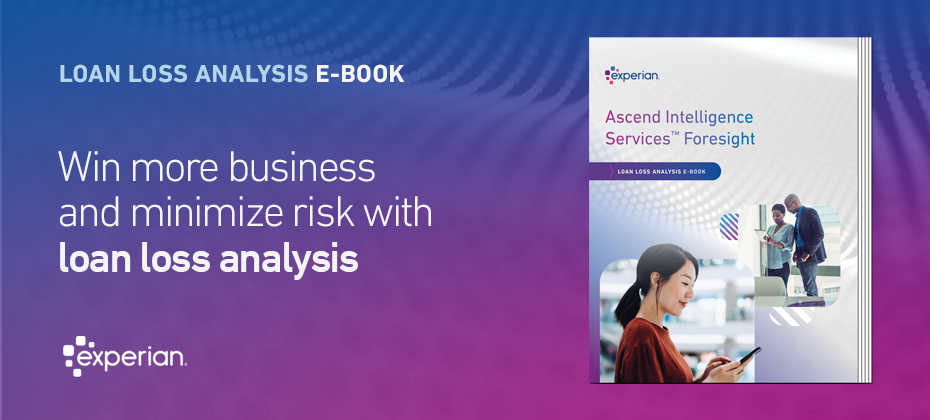
Lending institutions need to use the right business strategies to win more business while avoiding unnecessary risk, especially regarding lending policies. A recent study revealed that 48% of American loan applicants have been denied over the past year, with 14% facing multiple rejections. Additionally, 14% of rejected applicants felt pressured to seek alternative financing like cash advances or payday loans.1 These statistics highlight the need for financial institutions to offer attractive loan options to stay ahead in the industry. Understanding loan loss analysis Loan loss analysis is a powerful tool that helps lenders gain insights into why applicants book loans elsewhere. Despite efforts to target the right consumers at the right time with optimal offers, applicants sometimes choose to book their loans with different institutions. The lack of visibility into where these lost loans are booked can hinder a lender’s ability to improve their offerings and validate existing policies. By leveraging loan loss analysis, lenders can turn valuable data into actionable insights, creating more profitable business opportunities throughout the entire customer lifecycle. Gaining deep consumer insights Loan loss analysis provides visibility into various aspects of competitors’ loan characteristics, such as: Type of financial institution: Identifying whether applicants prefer banks, credit unions or finance companies can help lenders tailor their offerings. Average loan amount: Understanding how much other institutions offer allows lenders to adjust their loan amounts to be more competitive. Interest rates: Comparing interest rates with competitors helps lenders calibrate their rates to attract more business. Loan term length: Knowing the term lengths offered by competitors can inform decisions on loan terms to make them more appealing. Average risk score: Determining the risk scores of loans booked elsewhere helps lenders optimize their policies to maximize earning potential without increasing default risk. Making profitable decisions with business intelligence Experian's loan loss analysis solution, Ascend Intelligence Services™ Foresight, offers comprehensive insights to help lenders: Book more loans Increase profitability Enhance acquisition strategies Improve customer retention Optimize marketing spend By determining where applicants ultimately book their loans, lenders can unlock deep insights into competitors’ loan characteristics, leading to more intelligent business decisions. Read our latest e-book to discover how loan loss analysis can help you gain visibility into competitor offerings, improve your lending policies, book higher-performing loans, and minimize portfolio risk. Read the e-book Visit our website 1 Bankrate, February 2025. Survey: Almost half of loan applicants have been denied over the past 12 months.

Customer retention is crucial for lenders to maximize lifetime value, especially during economic uncertainty. Increasing customer retention rates by just 5% can boost profits by 25% to 95%. However, many lenders struggle with loyalty, as seen in Q2 2024 when mortgage servicers’ retention rates for refinances dropped to 20%, the second lowest in 17 years. Nonbanks and banks also saw significant declines. This is due to increased competition, changing economic conditions, and a lack of personalization. Key strategies for improving customer retention Lenders can improve retention by leveraging data for personalization, maintaining consistent communication, offering loyalty rewards, and utilizing retention triggers. Leverage data for personalization. Use customer data to offer tailored products and refinancing options based on financial behaviors. Using credit attributes, trended data and alternative credit data (alternative financial services data, cashflow attributes, etc.) can help provide deeper insights of your customers. Maintain consistent communication. Keep customers informed with regular updates about interest rate changes or new loan products. Use a variety of communication channels, including email and in-app messaging, to ensure customers are kept in the loop. Ensure your customer service team is always available and responsive, offering clear answers to any financial concerns. Offer loyalty rewards. Develop programs that reward repeat business and referrals. Offer special rates or discounts for returning customers or for those who refer friends and family to your services. Increase customer lifetime value (LTV) by offering additional services like financial planning or credit score monitoring. Utilize retention triggers. Identify key events for engagement with automated retention triggers. For example, a borrower who has a mortgage with a fixed rate may be less likely to consider refinancing unless prompted. Experian’s Retention TriggersSM can notify lenders when refinancing might be beneficial to their customer, offering them personalized incentives or new product options at the right time. Why Experian’s Retention Triggers? By integrating Experian’s Retention Triggers, lenders can keep borrowers engaged, increase retention, and boost profitability even in tough economic times. Advanced data insights: Gain deeper insights into your customers’ behavior to identify those at risk of leaving and take proactive action. Personalized engagement: Automate personalized communications based on customer behaviors, ensuring timely engagement. Increased revenue: By offering personalized, timely and relevant offers, you can increase the likelihood of retaining your customers and growing your revenue. Make customer retention a priority In today’s challenging economic climate, lenders who focus on personalized experiences, consistent communication, and relevant offers will stand out and retain borrowers. Leverage tools like Experian’s Retention Triggers to proactively engage customers, reduce churn, and foster long-term relationships for increased profitability and success. Learn more